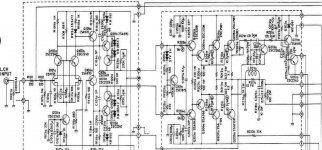I got a old Luxman where the outputs on one channel were blown.
I replaced blown resistors, the power transistors, drivers, predrivers and so on (actually all transistors on the mainboard were replaced). The bias was adjusted at near the same level as the other, working channel, and the repair seemed to be sucess. But, after about three hours listening to music at a moderate level, my loudspeakers suddenly delivered a load 50 Hz sinewave. It turned out that the outputs on the same channel had gone again. Does anyone have a suggestion on what is going on? Oscillation?
I replaced blown resistors, the power transistors, drivers, predrivers and so on (actually all transistors on the mainboard were replaced). The bias was adjusted at near the same level as the other, working channel, and the repair seemed to be sucess. But, after about three hours listening to music at a moderate level, my loudspeakers suddenly delivered a load 50 Hz sinewave. It turned out that the outputs on the same channel had gone again. Does anyone have a suggestion on what is going on? Oscillation?
Hi iwahn,
You may have had a couple things go wrong. The new outputs may have been fakes. You could also have had an intermittent crack in a trace. Carefully check the bias circuit.
I don't think you had oscillation, those problems seem to show up more quickly. I did have an amp go into oscillation after 20 min. on hot test into a dummy load. Not straight away.
Check each component again as if this is the first time you've seen the amp. Assume nothing. (that's the hardest part - I know)
-Chris
You may have had a couple things go wrong. The new outputs may have been fakes. You could also have had an intermittent crack in a trace. Carefully check the bias circuit.
I don't think you had oscillation, those problems seem to show up more quickly. I did have an amp go into oscillation after 20 min. on hot test into a dummy load. Not straight away.
Check each component again as if this is the first time you've seen the amp. Assume nothing. (that's the hardest part - I know)
-Chris
Hi Arif,
Runaway and bias are the tech's fault. They will show up on the bench while setting bias. Poor mounting is also the tech's fault.
I've seen lot's of the above over many years. I'm convinced that if you have a technician that can do this properly, KEEP HIM!
'nough said.
-Chris
Runaway and bias are the tech's fault. They will show up on the bench while setting bias. Poor mounting is also the tech's fault.
I've seen lot's of the above over many years. I'm convinced that if you have a technician that can do this properly, KEEP HIM!
'nough said.
-Chris
Thanks for your replies.
I have now carefully examined the traces and checked the remaining components and can not find any sign of cracks or bad solderings.
I have absolutely no idea why the outputs suddenly and with no warning goes up in smoke. The temperature was repeatedly checked during the tree hours it worked, and it showed no sign of thermal runaway. I got the amplifier from a friend who had tried to get it fixed, but the technican gave it up.
Iwahn
I have now carefully examined the traces and checked the remaining components and can not find any sign of cracks or bad solderings.
I have absolutely no idea why the outputs suddenly and with no warning goes up in smoke. The temperature was repeatedly checked during the tree hours it worked, and it showed no sign of thermal runaway. I got the amplifier from a friend who had tried to get it fixed, but the technican gave it up.
Iwahn
Hi Iwahn,
Something is changing here. It might be worthwhile to check the zobel capacitor and some of the HF bypass caps. When it's on the bench, run it hard into a dummy load of 8 ohms (just into clipping) to check that the outputs can deliver full voltage. Do the same with a 4 ohm load to make sure it will hang together at higher currents. As this point the heatsink should be warm. Reduce the level and get it to 50 or 60 °C and measure the bias (disconnect load, signal zero). This normally shakes most problems out.
Now it will either be running or blown again. You should know whether you have a bias problem (under compensation) or oscillation. Or you may have counterfit output devices, those numbers are very old.
-Chris
Something is changing here. It might be worthwhile to check the zobel capacitor and some of the HF bypass caps. When it's on the bench, run it hard into a dummy load of 8 ohms (just into clipping) to check that the outputs can deliver full voltage. Do the same with a 4 ohm load to make sure it will hang together at higher currents. As this point the heatsink should be warm. Reduce the level and get it to 50 or 60 °C and measure the bias (disconnect load, signal zero). This normally shakes most problems out.
Now it will either be running or blown again. You should know whether you have a bias problem (under compensation) or oscillation. Or you may have counterfit output devices, those numbers are very old.
-Chris
- Status
- This old topic is closed. If you want to reopen this topic, contact a moderator using the "Report Post" button.
- Home
- Amplifiers
- Solid State
- Repairing a luxman M-120A
